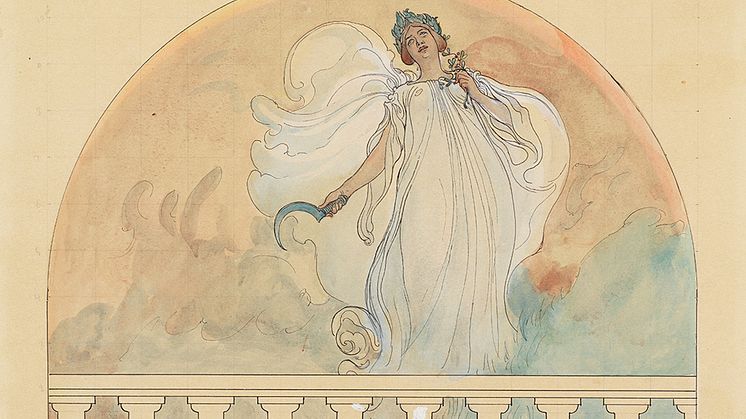
Press release -
Sketches by Carl Larsson acquired for Nationalmuseum’s collection
On a night at the Opera, the performance is of course the main focus. However, the interval can also serve up artistry of the highest order. The foyer of the Royal Opera in Stockholm is where Carl Larsson painted some of his best works for public spaces, featuring images from the history of musical theatre. Nationalmuseum has now acquired nine watercolour sketches for the foyer’s ceiling and wall paintings, dated 1896–97, illuminating the artist’s final vision.
Carl Larsson is perhaps best known for his watercolours of his family and home life, as depicted in the 24 pictures from Lilla Hyttnäs in Sundborn, Dalarna, published in the book A Home in 1899. But during the same period that he was painting the watercolours for A Home, the artist was also working on the decorations for the foyer of the Royal Opera in Stockholm, known as the Golden Foyer, to which audiences can retire during the intervals. The commission to produce monumental paintings for the public space brought Carl Larsson prestige and money, but was also incredibly laborious. He had actually recommended Anders Zorn for the job, but when that failed to materialise he took on the decoration of the foyer in March 1896, while the ceiling in the auditorium was painted by Vicke Andrén. Larsson’s paintings in the foyer were completed in December 1897, ready for the Opera’s inauguration the next year.
The watercolours present the compositions almost exactly as they were executed. The motif of the long ceiling painting, which measures 10.5 x 2.5 m in the opera house (and 98 x 27 cm in the sketch), is a playful allegory: the floating goddess of fame blows a trumpet as 18 naked children – wingless putti – raise the union flag in the centre of the image, where the huge chandelier also hangs. They grasp and pull the flag’s halyard but appear almost weightless in the summer breeze.
For the six lunettes, the semi-circular panels above the cornice, Carl Larsson painted four scenes illustrating the history of music in the theatre, along with two more specifically about the Royal Opera in Stockholm. The subjects of the first four are The Heroic Ballad, The Folk Song, The Medieval Mystery Play and The Carousel. The last two feature singers Carl Stenberg and Elisabeth Olin rehearsing for a gala performance of Cora och Alonzo which opened King Gustav III’s opera house in 1782, and Jenny Lind performing the aria “Casta Diva” from Bellini’s Norma. All the paintings were completed as oils on canvas in Carl Larsson’s Södermalm studio and then installed in the new opera house on Gustav Adolfs torg.
“I think the paintings in the Opera foyer are Carl Larsson’s finest public works – alongside the frescoes on Nationalmuseum’s staircase. But they can be difficult to fully appreciate from the floor of the foyer. The sketches allow us to study these important compositions and display them in a more accessible way,” explains Martin Olin, Director of Collections at Nationalmuseum.
The nine sketches for the Opera foyer’s paintings that Nationalmuseum has now acquired were first gifted to Folkets hus in Stockholm in 1901 by Carl Larsson himself. Folkets hus then sold off parts of its art collection in summer 2023. Nationalmuseum receives no public funding for new acquisitions, but relies on gifting and financial support from private foundations and trusts to enhance its collections of fine art, applied art and design. This acquisition was funded by a donation from Hedda and N.D. Qvist.
Inventory numbers
Carl Larsson, Plafond (Fama), 1896–97. Watercolour, ink, pencil and bodycolour on paper. NMB 2833
Carl Larsson, Gustav III’s monogram and Oscar II’s monogram. Double medallion in single frame, 1896-97. Watercolour, ink and pencil on paper. NMB 2834A-B.
Carl Larsson, Kämpasången; Karusellen; Jenny Lind. Three lunettes in single frame, 1896–97. Watercolour, ink, pencil and bodycolour on paper. NMB 2835A-C.
Carl Larsson, Stenberg och Fru Olin; Folkvisan; Medeltidsmysteriet. Three lunettes in single frame, 1896-97. Watercolour, ink, pencil and bodycolour on paper. NMB 2836A-C.
For press information
Martin Olin, Director of Collections,martin.olin@nationalmuseum.se, +46 8 5195 4310 Hanna Tottmar, Head of Press, press@nationalmuseum.se, +46 8 5195 4400
Categories
Nationalmuseum is Sweden’s museum of art and design. The collections comprise some 700 000 objects, including paintings, sculpture, drawings and graphic art from the 16th century up to the beginning of the 20th century and the collection of applied art and design up to the present day. Nationalmuseum is a government authority with a mandate to preserve cultural heritage and promote art, interest in art and knowledge of art.

